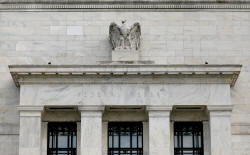The Fed's inflation story, in charts
 Send a link to a friend
Send a link to a friend
 [October 29, 2021] By
Howard Schneider [October 29, 2021] By
Howard Schneider
WASHINGTON (Reuters) - Federal Reserve
Chair Jerome Powell, in a high-profile speech in August, outlined the
arguments for why the current bout of high U.S. inflation will be
"transitory," and moderate on its own over time.
Since laying the case out, the evidence has been mixed. The U.S. central
bank meets next week to update its views about the economy and monetary
policy, and new data due to be released on Friday will be closely
watched as officials balance their hope to support the economy with low
interest rates for as long as possible against concerns inflation may be
moving too fast.
Here's how the inflation story has evolved:
HIGHER PRICES AHEAD
Fed officials knew early this year that inflation would rise as the
global economy rebounded from the coronavirus pandemic. But where some
economists felt record levels of federal spending would produce
persistent price increases, most Fed officials expected a fleeting
episode driven at first by simple math - the "base effects" of a weak
economy returning to normal - along with some inevitable bumps in the
reopening.
At their March 16-17 policy meeting, Fed officials marked up their
inflation outlook for 2021. Powell, speaking in a news conference after
the release of the policy statement and economic projections, said those
"relatively modest increases in inflation ... will turn out to be a
one-time sort of bulge ... There was a time when inflation went up, it
would stay up. And that time is not now."

By September, however, inflation was running at twice the Fed's 2%
target, and officials' projections moved higher.
(GRAPHIC: The Fed's inflation outlook -
https://graphics.reuters.com/USA-FED/INFLATION/gkvlgxyqnpb/
chart.png)
Powell's own language shifted. "As the reopening continues, bottlenecks,
hiring difficulties, and other constraints could again prove to be
greater and longer lasting than anticipated, posing upside risks to
inflation," he told reporters after the end of the central bank's Sept.
21-22 policy meeting.
(GRAPHIC: The COVID inflation surge -
https://graphics.reuters.com/USA-FED/INFLATION/akvezawxopr/
chart.png)
Some policymakers have pinpointed the end of the year as the moment when
inflation needs to ease, or they'll worry they got it wrong.
Powell and many others still think that will happen, but on a longer
timetable than first anticipated. New September data on Friday will be
parsed against the benchmarks Powell has laid out.
BROAD-BASED INCREASES?
"The spike in inflation is so far largely the product of a relatively
narrow group of goods and services that have been directly affected by
the pandemic and the reopening of the economy," Powell said in his
August remarks.
He cited the fact that alternate inflation measures which toss out the
strongest price influences remained moderate. But those measures have
moved higher since he spoke, reflecting broader price increases.
(GRAPHIC: Broad based inflation -
https://graphics.reuters.com/USA-FED/INFLATION/klpykzrowpg/
chart.png)

[to top of second column] |

Federal Reserve building is pictured in Washington, DC, U.S., August
22, 2018. REUTERS/Chris Wattie/File Photo

WANING INFLUENCE OF OUTLIERS
Policymakers, Powell said, are also "directly monitoring the prices of
particular goods and services most affected by the pandemic and the reopening,
and are beginning to see a moderation in some cases."
Powell cited the well-known example of used autos. Used vehicle prices rose at a
record pace over the summer, and that has in fact eased. But he also mentioned
that price hikes for durable goods in general should moderate, and by some
measures that has not yet happened.
(GRAPHIC: Pressure off the top? -
https://graphics.reuters.com/USA-FED/INFLATION/klvykzrrwvg/
chart.png)
WAGES
"Today we see little evidence of wage increases that might threaten excessive
inflation," Powell said in August. "We will continue to monitor this carefully."
The costs of compensation have not yet increased at a rate beyond the pace of
inflation plus the rise in worker productivity. That's the rough measure for
whether higher employee costs might lead to higher prices. If employee costs
rise faster than inflation and the change in the value of what each worker
produces, the Fed would take note.
(GRAPHIC: Wage and benefit costs -
https://graphics.reuters.com/USA-FED/INFLATION/zdvxorebnpx/
chart.png)
EXPECTATIONS
"Longer-term inflation expectations have moved much less than actual inflation
or near-term expectations, suggesting that households, businesses, and market
participants also believe that current high inflation readings are likely to
prove transitory," Powell said.An argument can be made that the Fed is paying
more attention to expectations than inflation itself, though measurement of them
is less certain. They have been drifting higher, and if that continues it would
be of particular concern.
(GRAPHIC: Inflation expectations ratchet higher -
https://graphics.reuters.com/
USA-FED/INFLATION/
gdvzywakwpw/
chart.png)
'GLOBAL DISINFLATIONARY FACTORS'
Perhaps the most faith-based aspect of Powell's August speech was his reference
to the global influence of technology, demographics, and smooth world supply
chains in anchoring prices.

(GRAPHIC: Global disinflation -
https://graphics.reuters.com/USA-FED/INFLATION/xmvjolddxpr/
chart.png)
"While the underlying global disinflationary factors are likely to evolve over
time, there is little reason to think that they have suddenly reversed or
abated," Powell said. "It seems more likely that they will continue to weigh on
inflation as the pandemic passes into history."The truth of that will depend on
developments far outside the Fed's control, from the global flow of capital to
China, for example, as the rule of Chinese leader Xi Jinping evolves, to the
impact of climate change mitigation efforts that are still in their infancy.
(Reporting by Howard Schneider; Editing by Dan Burns and Paul Simao)
[© 2021 Thomson Reuters. All rights
reserved.] Copyright 2021 Reuters. All rights reserved. This material may not be published,
broadcast, rewritten or redistributed.
Thompson Reuters is solely responsible for this content. |